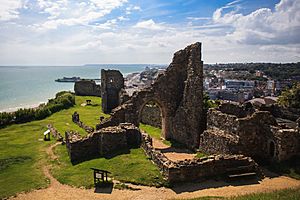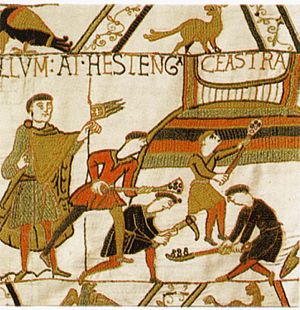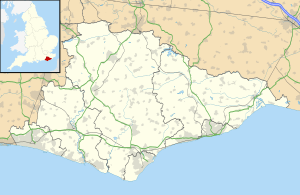Hastings Castle facts for kids
Quick facts for kids Hastings Castle |
|
|---|---|
| Hastings, East Sussex | |

General view of Hastings Castle
|
|
| Coordinates | 50°51′23″N 0°35′14″E / 50.85631°N 0.58731°E |
| Type | Keep and bailey |
| Site information | |
| Owner | Local Authority |
| Open to the public |
Yes |
| Condition | Fragmented Ruins |
| Site history | |
| Built | 12th Century |
| Materials | Stone |
| Demolished | Ruined by 1399 |
Hastings Castle is an old castle ruin in Hastings, East Sussex. It sits high up, looking over the English Channel. Over many years, parts of the castle have fallen into the sea.

Contents
History of Hastings Castle
Building the First Castle
In 1066, William the Conqueror landed in England. He quickly ordered three forts to be built. One of these was Hastings Castle. It was built just before the famous Battle of Hastings.
The first Hastings Castle was a motte-and-bailey castle. This means it had a large dirt mound (motte) with a tower. It also had a walled yard (bailey) below.
From Wood to Stone
Later in 1066, William won the Battle of Hastings. In 1070, he ordered the castle to be rebuilt. This time, it was made of strong stone. A chapel called St Mary's was also built inside.
Changes in Ownership
For a long time, the Counts of Eu owned the castle. But King John later ordered it to be destroyed. He did not want it to fall into enemy hands.
In 1220, King Henry III made the castle strong again. He added more defenses to it.
Later, the family who owned the castle lost control of it. This happened because the heir chose his French lands over his English ones. In 1242, King Henry III gave the castle to his wife's uncle, Peter II of Savoy. Peter looked after the castle until he passed away.
Nature's Impact on the Castle
In 1287, huge storms hit the south coast. The soft cliffs beneath the castle began to crumble. Large parts of the castle fell into the sea.
The town of Hastings was attacked by the French in 1339 and 1377. Many buildings, including homes, were burned. Over the next hundred years, more of the castle was lost to the sea. This was due to natural erosion.
Later Years and Rediscovery
In the mid-1500s, Henry VIII ordered many Catholic monasteries to be destroyed. This left the castle site in ruins.
In 1591, Thomas Pelham bought the land. The Pelham family then used the site for farming. The ruins became so overgrown that people forgot they were there.
In 1824, the Earl of Chichester owned the land. He asked for some digging to be done. During this work, parts of the chapel floor and walls were found. They were rebuilt using stones found nearby.
During World War II, Hastings was bombed. The castle ruins were damaged even more. In 1951, the Hastings Corporation bought the site. They turned it into a place for visitors to enjoy.
Today, Hastings Castle is open to the public. You can visit it between March and October.


